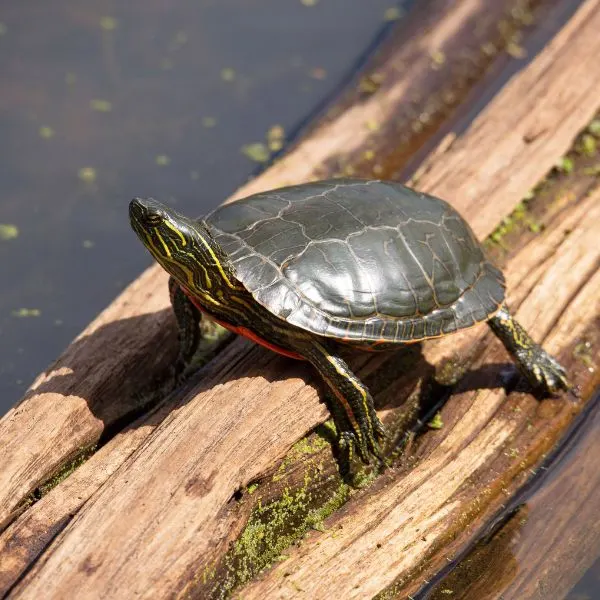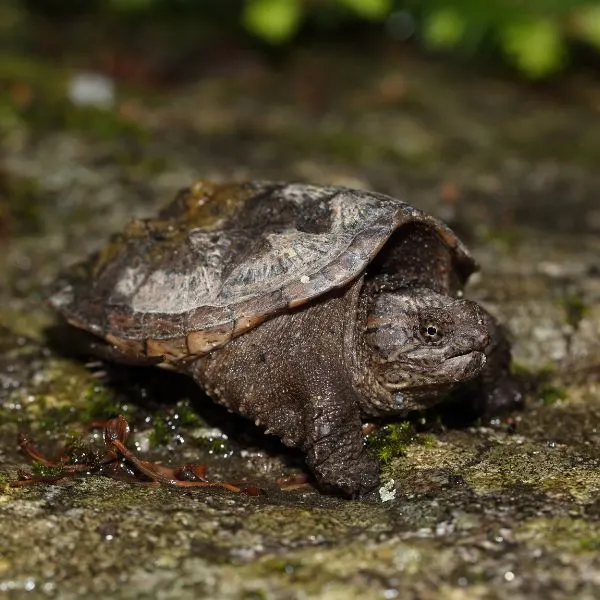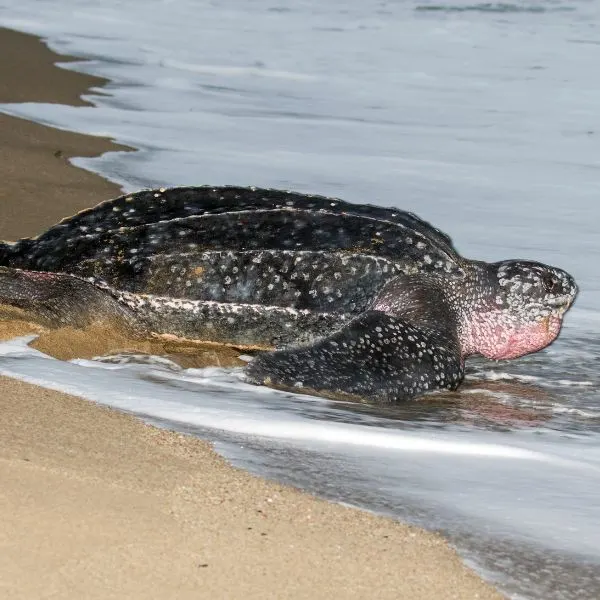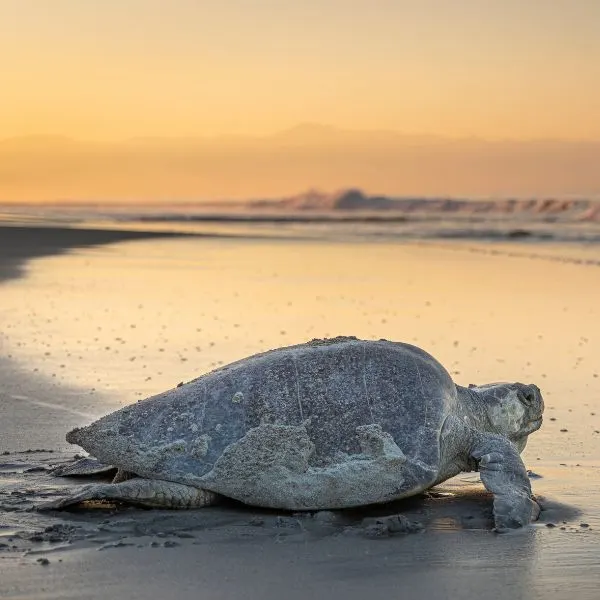There are two native species of turtles in Oregon, but the state hosts 2 non-native turtle species and 4 species of Sea turtles. With its wide climate range and over 350 miles of coast, Oregon has the perfect environment for a wide array of turtles.
Most species of turtles are in decline though they haven’t warranted protection from Fish And Wildlife Services or other Federal agencies. Through education, awareness, and conservation efforts we can save these reptiles from becoming extinct.
Here are the 8 species of turtles that can be found in Oregon and along the Pacific Coast.
Table of Contents
Turtles in Oregon
1. Western Pond Turtle

- Experience Level: Intermediate to Expert
- Family: Emydidae
- Scientific Name: Actinemys Marmorata
- Other Names: Pacific Pond turtle, Northwestern Pond Turtle
- Adult Size: Between 4 and 9 inches
- Life Span: Between 30 and 50 years
- Average Price Range: Around $500 (very rare as they are difficult to breed, and illegal to own in many states)
- Conservation status: Vulnerable
The Western Pond turtle is one of two native turtle species in Oregon. Despite the fact that it lives along the whole western coast of the United States, it is facing serious challenges in its fight for survival.
Because of habitat destruction, urbanization, and agricultural needs, the Western Pond turtle is struggling to survive. In the State of Oregon, this turtle is a protected species, and it’s illegal to own, take, or sell these animals.
The Western Pond turtle has a slightly domed shell that’s olive or dark brown. It may have some darker streaks, but many do not. The plastron (lower part of the shell) is a pale yellow color and may have dark blotches on each of the scutes.
They have dark brown to black skin with pale yellow markings. Males often have a white or yellow throat.
Despite being called pond turtles, they can also live in rivers, lakes, and other bodies of water. What they really look for is abundant vegetation, fallen logs, basking boulders, or other places they can soak up some sun rays.
These turtles are very shy and elusive, even when they are captive bred. If you’re looking for an interactive pet, stay away from the Western Pond turtle. They will always remain skittish and introverted.
They are omnivorous and enjoy feeding on insects, crustaceans, algae, grass, and even dead animals.
Painted Turtles in Oregon
2. Western Painted Turtle

- Experience Level: Beginner
- Family: Emydidae
- Scientific Name: Chrysemys Picta Belli
- Other Names: N/A
- Adult Size: Between 4 and 10 inches
- Life Span: Between 30 and 50 years
- Average Price Range: Between $30 and $150
- Conservation Status: Least concern, “sensitive” in the state of Oregon
The Western Painted turtle is the only other Oregon native. Just like its western pond cousin, it is facing severe population declines in the state of Oregon and is illegal to own as a pet. If you live in Oregon and would like to have this beautiful specimen as a pet you’re out of luck.
Check out our exhaustive guide on turtle laws to learn more about what turtles you can legally own and where.
One of the main reasons Western Painted turtles are facing declines in Oregon is because they enjoy living in the same waters as the Western Pond turtle.
These turtles even look similar to the Pond turtle, except the Painted turtle has a bit more color. They have bright yellow stripes all along their exposed extremities, and their plastron is bright red with a mirrored, decorative pattern.
Western Painted turtles are omnivores that feed on aquatic plants, fish, and underwater invertebrates.
Snapping Turtles in Oregon
3. Common Snapping Turtle

- Experience level: Intermediate to Expert
- Family: Chelydrida
- Scientific Name: Chelydra Serpentina
- Other Names: Snapping Turtle, Snapper, Eastern Snapping Turtle
- Average Adult Size: 8 to 20 inches
- Life Span: 30 – 50 years
- Average Price Range: Approximately $40 to $120
- Conservation Status: Least concern
- Recommended Books: Snapping Turtle Pet Owner’s Guide by Ben Team
Common Snapping turtles are native to most eastern states, but they have made their way all the way West to the Beaver State. Since both of Oregon’s native turtles are in such danger, it’s illegal to own, sell, release, or import Common Snapping turtles.
You can blame others for causing this problem. When these turtles are released or escape their enclosures, they can easily establish an invasive community. Snapping turtles get very large, and will eat small hatchling turtles and out compete native species.
These turtles have ridged carapaces (upper shells) that are solid colored. They have long necks, tails, and strong limbs that they can’t completely pull into their shell.
Common Snappers can survive in most types of water, though they prefer slow moving and permanent bodies of water.
Here they spend most of their time at the bottom. They rarely bask, but in colder states, they may come out more often.
They are opportunistic feeders. As they wait at the bottom of the water, they will snatch up anything small enough to fit in their mouths such as fish, frogs, tadpoles, crayfish, insects, and snails. Sometimes they eat vegetation as well.
Pond Sliders in Oregon
4. Red Eared Slider

- Experience level: Beginner
- Family: Emydidae
- Scientific Name: Trachemys scripta elegans
- Common Name: Pond slider, Red-eared terrapin, Water slider
- Average Adult Size: 6 – 8 inches
- Life Span: 20 to 40 years
- Average Price Range: approximately $30 to $100
- Conservation Status: Least concern
And in this corner, we have another turtle that is illegal to own in Oregon. The ever popular Red Eared Slider is a turtle known to colonize every continent except Antarctica.
If these turtles are released from captivity, they find water and then bully, and breed the other turtles out of the water. They have recently found their way into Oregon waters and they pose a significant threat to the already endangered native turtles.
Red Eared Sliders aren’t bad turtles, they just do what comes naturally, but in non-native lands, there are few threats to keep them in place. They can make great pets, but people have to realize, these turtles can live for 30 or even 40 years, and they need a lot of space!
Appearance wise, these turtles are rather colorful. Their carapace is green with colorful markings of orange, yellow, brown, red, and black. Their plastron is pale yellow and often black spotted.
Their skin is olive to black with yellow stripes, and they have a pair of red patches that look like ears.
They prefer slow-moving waters but can make due in nearly any type of freshwater, from swamps and wetlands to rivers and lakes. Red Eared Sliders are also omnivores so they can feed on vegetation and aquatic organisms such as fish, shrimp, crayfish, clams and mussels, mollusks, and insects.
Sea Turtles in Oregon
5. Green Sea Turtle

- Experience level: N/A, Illegal to own any sea turtle
- Family: Cheloniidae
- Scientific Name: Chelonia mydas
- Other Names: Green Sea Turtle
- Average Adult Size: 3 – 4 feet
- Life Span: 50 – 70 years
- Average Price Range: N/A
- Conservation Status: Endangered
The Green Sea turtle is the first of the four sea turtles that can be found in the coastal areas of Oregon’s waters. It is one of the most popular, quite beautiful, and a very endangered turtle.
This is the second largest hard-shelled sea turtle species. Though they can reach lengths slightly longer than the Loggerhead Sea turtle, the Green Sea turtle doesn’t get as hefty.
See, turtles are measured by carapace length. When a turtle is 20 inches long, that’s just the shell, not the neck and tail. In all actuality, a 20-inch turtle could actually be twice as long (especially when measuring a long necked, and long tailed turtle such as the Common Snapping turtle).
The Green Sea turtle is an herbivore. It feeds almost exclusively on sea grasses and algae as an adult. Hatchlings and juveniles feed on krill, fish, snails, and other small protein based organisms.
Some of the biggest threats that these Sea turtles face are harvesting for eggs, food, leather, and even souvenirs. Another major threat is becoming entangled in commercial trawling nets and other fishing gear.
6. Leatherback Sea Turtle

- Experience level: N/A, Illegal to own any sea turtle
- Family: Dermochelyidae
- Scientific Name: Dermochelys coriacea
- Other Names: Atlantic Leatherback, Leatherback
- Average Adult Size: 4 – 8 ft
- Life Span: 30 – 50 years
- Average Price Range: N/A
- Conservation Status: Endangered
Leatherback Sea turtles are the largest species of turtle in the world. It is believed that the Leatherback Sea turtle has changed very little, if at all, since the age of dinosaurs.
They prefer tropical and subtropical areas and have the widest distribution among reptiles, but have been observed in waters too cold for other Sea turtle species. They are great swimmers (what a surprise) and are highly migratory—they can swim over 10,000 miles a year to get from foraging to nesting grounds and vice versa.
As the name suggests, the Leatherback Sea turtle doesn’t have a typical hardened carapace. The shell is relatively smooth and leathery in appearance, with seven ridges running from the front to the back.
These huge turtles stay out in the open sea and only come to land to lay their eggs. While traversing the globe, Leatherbacks search for giant jellyfish, their staple diet. They also eat squid, fish, and sea squirts, but most of their massive caloric intake is from lion’s mane jellies.
7. Loggerhead Sea Turtle

- Experience Level: N/A, Illegal to own any sea turtle
- Family: Cheloniidae
- Scientific Name: Caretta Caretta
- Other Names: Loggerhead
- Adult Size: 2.5 – 3.5 feet
- Life Span: 70 – 80 years
- Average Price Range: N/A
- Conservation Status: Endangered
Loggerhead Sea turtles are easily recognizable by their large heads and strong jaws. They need these powerful jaws to crack the shells of conch, whelk, horseshoe crabs, and other crustaceans.
Loggerhead Sea turtles are the largest hard shelled turtles in the world. They have somewhat heart-shaped shells, long flippers, and broad heads. Their carapace is reddish-brown, as are their flippers and the top of their head. Their underside is pale yellow, tan, or white.
While these sea turtles are still endangered, the Loggerhead species is the most abundant of them all thanks to education and conservation efforts.
8. Olive Ridley Turtle

- Experience level: N/A, Illegal to own any sea turtle
- Family: Cheloniidae
- Scientific Name: Lepidochelys olivacea
- Other Names: Ridley sea turtle
- Average Adult Size: 20 – 29 inches
- Life Span: 40 – 50 years
- Average Price Range: N/A
- Conservation Status: Endangered
Olive Ridley Sea turtles are among the smallest of all Sea turtles. They have small, heart-shaped, olive colored shells, and their front flippers have either one or two claws on them.
These turtles have strong numbers but are still in decline.
Olive Ridley Sea turtles are one of only a few species that practice what is called arribada—translated from Spanish to English it means arrival. Arribada is where female turtles gather off the coast and then mass migrate to the beach to lay their eggs nearly at the same time.
On some tropical beaches, hundreds of thousands of Olive Ridleys descend on the sands at once, lay their eggs, and leave. It’s an amazing sight!
Olive Ridley Sea turtles are omnivores that feed on algae, crustaceans, mollusks, tunicates (think sea squirts and other similar invertebrates), and other small organisms.
Wrapping up
Though Oregon is home to a few species of turtles, owning one as a pet may entail “jumping through a few hoops.” For more information, check local laws on turtle ownership, and check out our guide on turtle laws.
To help save native turtles, never release pet turtles into the wild. It may seem like the right thing to do, but as in the case of the Red Eared Slider, and Common Snapper, these turtles can put stress on native turtles who are already barely holding on.
When you have a turtle you can no longer care for, search for a reptile rescue agency, search social media for someone who might want to adopt it from you or contact your local vet. They often can either take them for you or provide you with valuable information.
We hope you enjoyed the list of Oregon turtles. Before you go, please leave us a comment below. We love to hear from readers, and you may be able to connect with fellow turtle enthusiasts.
Other nearby states
